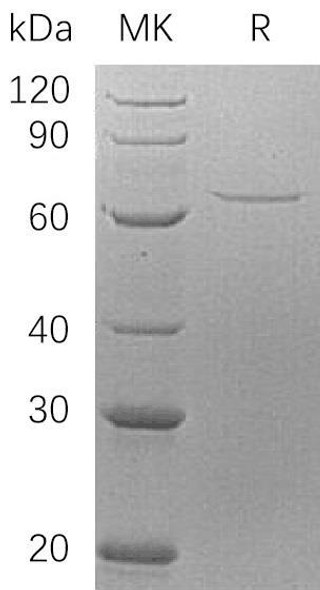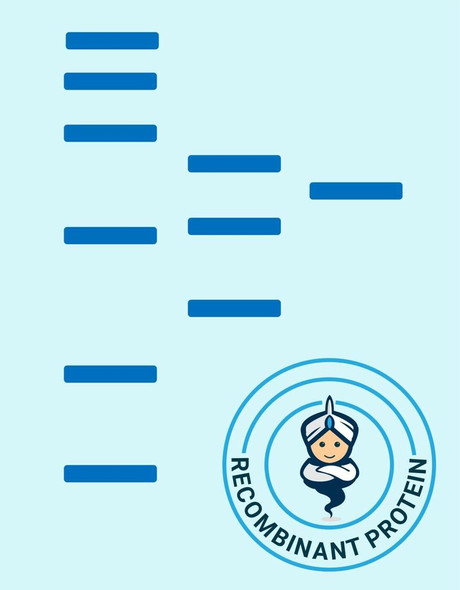Description
| Product Name: | Human AIFM1 Recombinant Protein |
| Product Code: | RPPB2723 |
| Size: | 20µg |
| Species: | Human |
| Target: | AIFM1 |
| Synonyms: | Apoptosis-inducing factor 1, mitochondrial, Programmed cell death protein 8, AIFM1, AIF, PDCD8, CMTX4, COWCK, COXPD6, isoform 2 precursor, Apoptosis-Inducing Factor, Mitochondrion-Associated, 1. |
| Source: | Escherichia Coli |
| Physical Appearance: | Sterile Filtered colorless solution. |
| Formulation: | The AIFM1 solution (0.5mg/ml) contains 20mM Tris-HCl buffer (pH 8.0), 0.1M NaCl and 10% glycerol. |
| Stability: | Store at 4°C if entire vial will be used within 2-4 weeks. Store, frozen at -20°C for longer periods of time. For long term storage it is recommended to add a carrier protein (0.1% HSA or BSA).Avoid multiple freeze-thaw cycles. |
| Purity: | Greater than 95.0% as determined by SDS-PAGE. |
| Amino Acid Sequence: | MGSSHHHHHH SSGLVPRGSH MGSEFLGLTP EQKQKKAALS ASEGEEVPQD KAPSHVPFLL IGGGTAAFAA ARSIRARDPG ARVLIVSEDP ELPYMRPPLS KELWFSDDPN VTKTLRFKQW NGKERSIYFQ PPSFYVSAQD LPHIENGGVA VLTGKKVVQL DVRDNMVKLN DGSQITYEKC LIATGGTPRS LSAIDRAGAE VKSRTTLFRK IGDFRSLEKI SREVKSITII GGGFLGSELA CALGRKARAL GTEVIQLFPE KGNMGKILPE YLSNWTMEKV RREGVKVMPN AIVQSVGVSS GKLLIKLKDG RKVETDHIVA AVGLEPNVEL AKTGGLEIDS DFGGFRVNAE LQARSNIWVA GDAACFYDIK LGRRRVEHHD HAVVSGRLAG ENMTGAAKPY WHQSMFWSDL GPDVGYEAIG LVDSSLPTVG VFAKATAQDN PKSATEQSGT GIRSESETES EASEITIPPS TPAVPQAPVQ GEDYGKGVIF YLRDKVVVGI VLWNIFNRMP IARKIIKDGE QHEDLNEVAK LFNIHED |
Apoptosis-Inducing Factor, Mitochondrion-Associated, 1 (AIFM1) is a mitochondrial protein which translocates to the nucleus once apoptosis has been initiated. AIFM1 causes DNA fragmentation and chromatin condensation and also triggers the release of cytochrome c and caspase-9 from mitochondria. Bcl-2 overexpression prevents the release of AIFM1 from mitochondria, but doesn�t block its apoptogenic activity.
AIFM1 Human Recombinant produced in E.coli is a single, non-glycosylated polypeptide chain containing 537 amino acids (98-609) and having a molecular mass of 58.5 kDa.AIFM1 is fused to a 25 amino acid His-Tag at N-terminus and purified by proprietary chromatographic techniques.
| UniProt Protein Function: | PDCD8: Probable oxidoreductase that has a dual role in controlling cellular life and death; during apoptosis, it is translocated from the mitochondria to the nucleus to function as a proapoptotic factor in a caspase-independent pathway, while in normal mitochondria, it functions as an antiapoptotic factor via its oxidoreductase activity. The soluble form (AIFsol) found in the nucleus induces 'parthanatos' i.e., caspase-independent fragmentation of chromosomal DNA. Interacts with EIF3G,and thereby inhibits the EIF3 machinery and protein synthesis, and activates casapse-7 to amplify apoptosis. Plays a critical role in caspase- independent, pyknotic cell death in hydrogen peroxide-exposed cells. Binds to DNA in a sequence-independent manner. Interacts with XIAP/BIRC4. Interacts (via N-terminus) with EIF3G (via C-terminus). Belongs to the FAD-dependent oxidoreductase family. 4 isoforms of the human protein are produced by alternative splicing. |
| UniProt Protein Details: | Protein type:Apoptosis; EC 1.-.-.-; Mitochondrial; Oxidoreductase Chromosomal Location of Human Ortholog: Xq26.1 Cellular Component: cytosol; mitochondrial inner membrane; mitochondrial intermembrane space; mitochondrion; nucleus Molecular Function:NAD(P)H oxidase activity; oxidoreductase activity, acting on NADH or NADPH; protein binding Biological Process: apoptosis; caspase activation; chromosome condensation; positive regulation of apoptosis Disease: Deafness, X-linked 5 |
| NCBI Summary: | This gene encodes a flavoprotein essential for nuclear disassembly in apoptotic cells, and it is found in the mitochondrial intermembrane space in healthy cells. Induction of apoptosis results in the translocation of this protein to the nucleus where it affects chromosome condensation and fragmentation. In addition, this gene product induces mitochondria to release the apoptogenic proteins cytochrome c and caspase-9. Mutations in this gene cause combined oxidative phosphorylation deficiency 6 (COXPD6), a severe mitochondrial encephalomyopathy, as well as Cowchock syndrome, also known as X-linked recessive Charcot-Marie-Tooth disease-4 (CMTX-4), a disorder resulting in neuropathy, and axonal and motor-sensory defects with deafness and mental retardation. Alternative splicing results in multiple transcript variants. A related pseudogene has been identified on chromosome 10. [provided by RefSeq, Aug 2015] |
| UniProt Code: | O95831 |
| NCBI GenInfo Identifier: | 13431764 |
| NCBI Gene ID: | 9131 |
| NCBI Accession: | O95831.1 |
| UniProt Secondary Accession: | O95831,Q1L6K4, Q1L6K6, Q2QKE4, Q5JUZ7, Q6I9X6, Q9Y3I3 Q9Y3I4, A4QPB4, B1ALN1, B2RB08, D3DTE9, |
| UniProt Related Accession: | O95831 |
| Molecular Weight: | 26,033 Da |
| NCBI Full Name: | Apoptosis-inducing factor 1, mitochondrial |
| NCBI Synonym Full Names: | apoptosis inducing factor mitochondria associated 1 |
| NCBI Official Symbol: | AIFM1�� |
| NCBI Official Synonym Symbols: | AIF; CMT2D; CMTX4; COWCK; DFNX5; NADMR; NAMSD; PDCD8; COXPD6�� |
| NCBI Protein Information: | apoptosis-inducing factor 1, mitochondrial |
| UniProt Protein Name: | Apoptosis-inducing factor 1, mitochondrial |
| UniProt Synonym Protein Names: | Programmed cell death protein 8 |
| Protein Family: | Putative apoptosis-inducing factor |
| UniProt Gene Name: | AIFM1�� |






